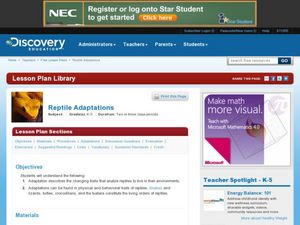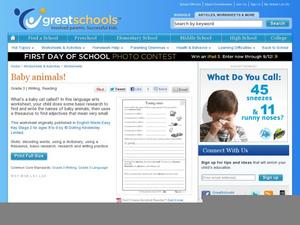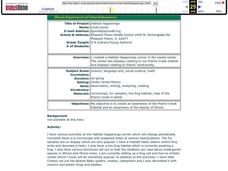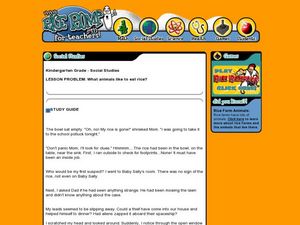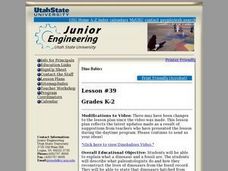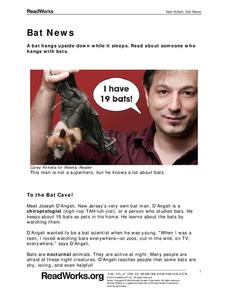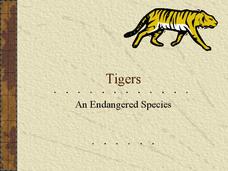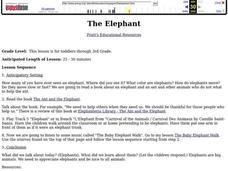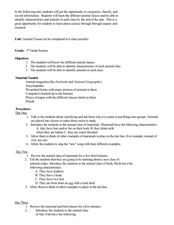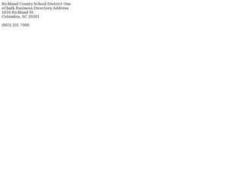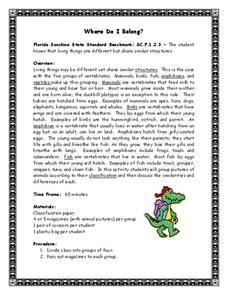Curated OER
Reptile Adaptations
Students research animal adaptations. In this adaptations lesson, students research the physical and behavioral adaptations of animals. Students create a diagram of their animal labeling it's adaptations.
Curated OER
Young Ones
This is the cutest reference materials activity ever! Researchers complete six sentences on baby animal names, continuing the pattern by writing five more sentences about other animals from their research. They use a thesaurus to look up...
Curated OER
Are You Aware?
In this reading comprehension worksheet, students read several short paragraphs about farm animals and then answer five multiple questions about each paragraph.
K12 Reader
Hide and Seek
Why do certain animals look the way they do? It could be because they have developed camouflage. Kids can read up on camouflage and mimicry and then respond to five questions related to the content of the passage.
Curated OER
Habitat Happenings
Pupils examine the characteristics of the Prairie Creek Habitat in Illinois. In groups, they travel between various stations writing haikus and reading brochures. They identify what occurs in each habitat and identify the animals located...
Curated OER
Science - What Can Living Things Do
In these living things worksheets, learners write true or false for the sentences about living things. Students answer the questions about living things and choose the words that best describe the statements about living things.
Curated OER
Animal Families
In this animal families worksheet, students match the name of a baby animals to the adult name. Next, they match the name of the animal to the name of its animal group, such as herd, pack, gaggle, etc. There are 15 baby animal names,...
Curated OER
Animals
Second graders define and describe the characteristics of a mammal and a mammal's importance to man. They also describe the life cycle of a frog and compare and contrast a larva and an adult frog. Finally, 2nd graders study and explain...
Curated OER
Animals who eat Rice
Students read a story and answer questions. In this reading for understanding lesson, students read a story and answer questions. Students also draw pictures of the story to help comprehension.
Curated OER
Dino Babies
Students distinguish between dinosaurs and fossils. They escribe what paleontologists do and how they reconstruct the lives of dinosaurs from the fossil record. In addition, they state that dinosaurs hatched from eggs.
Read Works
Bat News
Get the bat facts with a short nonfiction reading passage. After reading the passage, readers respond to questions that focus on main idea, inferencing, vocabulary in context, and author's purpose.
Scholastic
Study Jams! Animal Life Cycles
Only five slides, but worth the while for introducing upper-elementary zoologists to different animal life cycles. Two types of metamorphoses are explained: complete and incomplete. Stunning photography flows before the eyes of the...
Curated OER
Tigers: An Endangered Species
Facts about tigers are packed into a PowerPoint presentation about tigers. The presentation includes great photographs and accompanying text regarding the habitats, diet, lifespan, and physical attributes of tigers. Very interesting!
Curated OER
Baby Animals
In this baby animal graphic organizer, students write in four examples of young animals that look like their parents, and two examples of young animals that look different from their parents.
Curated OER
Look Alikes
Third graders compare and contrast the physical features of parents and offspring. For this life science lesson, 3rd graders classify a set of animal pictures according to their similarities. They share and explain their work in class.
Curated OER
The Elephant
Students listen to a story about helping others. In this citizenship lesson plan, students investigate a group of animals that do not want to help an ant. Students learn about elephants and sing songs about the elelphant in story.
Curated OER
Animal Classes
Third graders research animals through books and magazines and put them into their various classes. In this animal classes lesson plan, 3rd graders describe the characteristics of animals in each class.
Curated OER
Hatched From An Egg
Students discover how animals are born/hatched. In this life science lesson, students listen to a book entitled Chickens Aren't The Only Ones, and discuss animals that are hatched or born. Students receive a picture of an animal, they...
Curated OER
We're Zoologists!
Students listen to story, "Never, Ever Shout in a Zoo," by Karma Wilson, practice finding information from Internet, write information about one chosen zoo animal, draw picture of their zoo animal, pair up and read their My Zoo Animal...
Curated OER
Portrait Sculptures
Third graders identify characteristics that they have in common with animals. They create a self-portrait sculpture combining the body structures of different animals. They create the sculpture armature, plaster the armature, and then...
Curated OER
Bottle Dolls/Figurative Sculpture
Young scholars use water bottles with sand in them (to give stability) They add heads made of crumpled newspaper with masking tape. They paper mache the entire figure and make them into people or animals. Students add paint and...
Curated OER
Clifford Learns About the Circus and So Do We!
Students investigate the characteristics of different circus jobs and the animals commonly seen at the circus. They read a book about clowns and construct and perform a trick hot dog. Students also create a clown accordion book.
Curated OER
Where Do I Belong?
Fourth graders work in groups. They are given magazines. Students cut pictures of five mamals, five birds, five reptiles, five amphibians, and five fish. They place the pictures in a plastic bag. Students switch bags. They are explained...
Curated OER
Better Butter
Students explore the process of making butter. In this agriculture lesson, students discuss how butter is made today and how it was made in the past. Students make their own butter using baby food jars and some "elbow grease."


